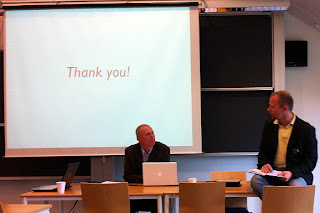 |
| Anders Bonde and Niels Hannibal from the HS group |
Lots of people(28) had enrolled, we had made our first experiments with our sensors, good discussions and feedback. And furthermore - a number of people asked to be enrolled in our activities!
The only thing more we could wish was well prepared tests with good results. We gained a large number of lesson learned regarding the use of sensors in single subject studies but we did not get scientific proof of the value of use of sensors.
The seminars conclusions - that is the minutes from the final discussion is available here.
The powerpoint presentation are accesible via the table below.
| Title | Presenter |
|---|---|
| Prehistory of Humansensing PPT | Morten Aagaard, Persuasive Design, AAU |
| An example of use of sensors in clinical research - ten years ago PPT | Hanne Mette Ridder, Associate Professor Music therapy AAU |
| Potentials, pittfalls and tradeoffs in the use of sensors in human science and related praxis fields PPT | Johan Trettvik, Psychology, Assistant Professor, AAU |
| Experiment I: Measuring Meditation PPT | Morten Aagaard, Persuasive Design, AAU |
| Experiment II: Measuring the Relation between Music and Moving Images Combining Physiological and Self-Raporting Data PPT | Anders Bonde, Music, Associate Professor, AAU |
| Experiment III: Quantified Self - 24/7 sensor diary PPT | Jonathan Led Larsen, psychologist, Region Nord |
| Sensors - state of the art | Neeli Prasad, Associate Professor at Center for Tele Infra Structure, AAU |
| Perspectives and announcement Summary of discussion Announcements | The Humansensing group |
Finally we would like to thanks all that has helped us. Financially or otherwise.
Professor Ramjee Prasad, CTIF, sponsoring the sensors
Christian Jantzen, head of Institute for communication and psychology, sponsoring equipments
Tove Arendt Rasmussen, head of Human Centered Communication and Informatics, sponsoring the lunch


